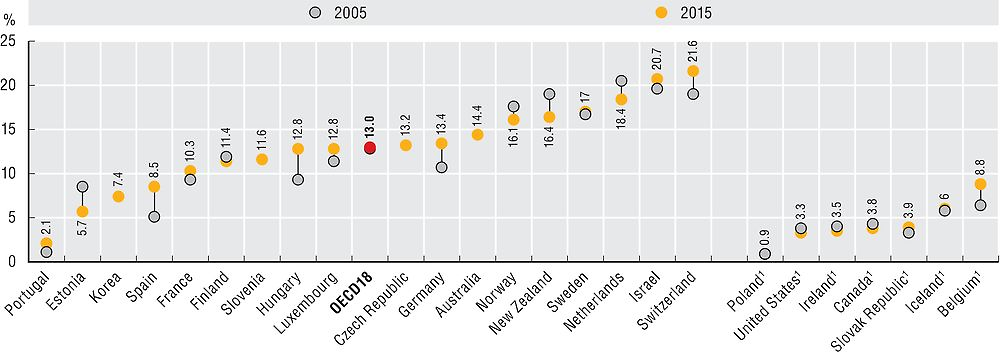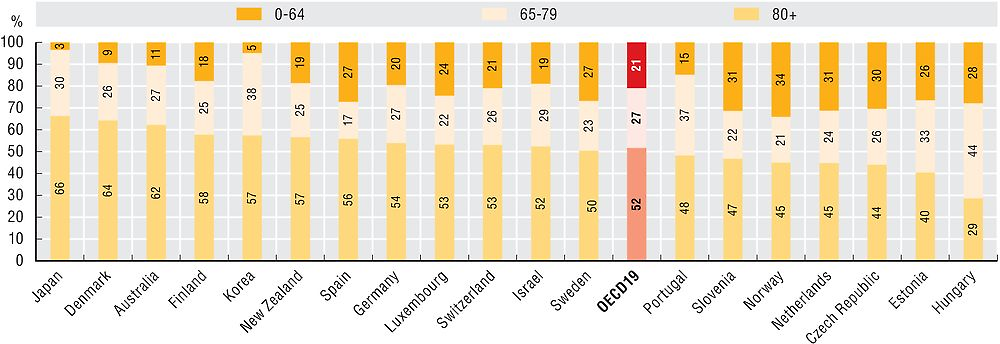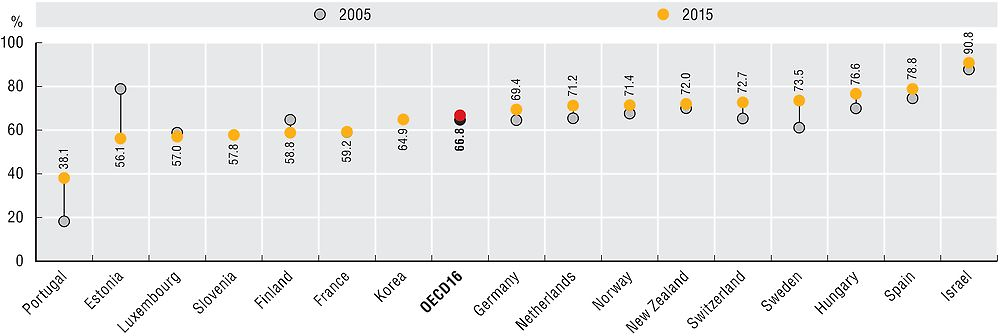Recipients of long-term care
As people age, they are more likely to develop disabilities and need support from family, friends and long-term care (LTC) services. As a result, while LTC services are delivered to younger disabled groups, the majority of LTC recipients are older people. On average across the OECD, 13% of people over 65 receive long-term care (Figure 11.13). The proportion of over-65s receiving long-term care varies from 2% in Portugal and 6% in Estonia to more than 20% in Israel and Switzerland.

1. These values include only recipients of long-term care in institutions.
Source: OECD Health Statistics 2017.
People aged over 80 make up on average more than half of all LTC recipients, and almost two-thirds of LTC recipients in Japan, Denmark and Australia (Figure 11.14). As populations age, demand for LTC services is likely to increase – although this effect may be partially offset by improving health in old age. Nonetheless, a significant number of younger disabled people require long-term care, making up as many as a third of all LTC recipients in Norway, Slovenia and the Netherlands.

Source: OECD Health Statistics 2017.
While population ageing is a significant driver of the growth in LTC users over time, it explains relatively little of the cross-country variation. For example, Israel has one of the youngest populations in the OECD but a greater than average proportion receiving LTC. A more important driver is the availability of publicly funded LTC services. However, data for people receiving care outside of public systems are more difficult to collect and may be underreported, meaning that figures for countries that rely more heavily on privately-funded care may be artificially low. Cultural norms around the degree to which families look after older people may also be an important driver of the utilisation of formal services (see indicator on “Informal carers”).
In response to most people’s preference to receive LTC services at home, many OECD countries have implemented programmes and benefits to support home-based care, in particular for older people. In most countries for which trend data are available, the proportion of LTC recipients aged 65 and over receiving long-term care at home has increased over the past ten years (Figure 11.15), with particularly large increases in Portugal and Sweden. In Portugal this reflects an expansion of home care services from a very low level in 2005. In Sweden it results from a deliberate policy to reduce institutional care capacity and encourage community care (Colombo et al., 2011).

Source: OECD Health Statistics 2017.
While the proportion of LTC recipients living at home has increased over the past decade in most OECD countries, it has declined significantly in Finland and Estonia. In Finland, this has not been driven by an increase in traditional institutional care. Instead, there has been an increase in the use of “service housing” – where older people move into specially adapted houses where 24/7 care is available. Although this is classified as institutional care, it allows more independence and autonomy than a traditional care institution. In Estonia, there has been a significant increase in the use of institutional care, but there has been an even larger decrease in the number of “curators” appointed by local government to care for people at home.
LTC recipients are defined as persons receiving long-term care by paid providers, including nonprofessionals receiving cash payments under a social programme. They also include recipients of cash benefits such as consumer-choice programmes, care allowances or other social benefits which are granted with the primary goal of supporting people with long-term care needs. LTC institutions refer to nursing and residential care facilities which provide accommodation and long-term care as a package. LTC at home is defined as people with functional restrictions who receive most of their care at home. Home care also applies to the use of institutions on a temporary basis, community care and day-care centres and specially designed living arrangements. Data for Poland, the United States, Ireland, Canada, the Slovak Republic, Iceland and Belgium are only available for people receiving long-term care in institutions, so the total number of recipients will be underestimated. In Estonia, data on recipients of home care refer only to those who have a “curator” appointed by local government. Other social services, without a personal care component, are not included in the data. It is possible that some of the decrease in recipients reflects the replacement of curators with these other services.
Data on LTC services is difficult to collect in many countries and there are some known limitations of the figures. Data for some countries refer only to people receiving publicly-funded care, while other countries include people who are paying for their own care. Data from France and the Czech Republic refer to the number of people claiming care benefits, which may not correspond directly to the number receiving services. Some countries use different age categories: instead of reporting people aged 65 and over, Belgium reports those aged 60 and over and Iceland those aged 66 and over.
References
Colombo, F. et al. (2011), Help Wanted? Providing and Paying for Long-Term Care, OECD Publishing, Paris, https://doi.org/10.1787/9789264097759-en.
Muir, T. (2017), “Measuring Social Protection for Long-term Care”, OECD Health Working Papers, No. 93, OECD Publishing, Paris, https://doi.org/10.1787/a411500a-en.
